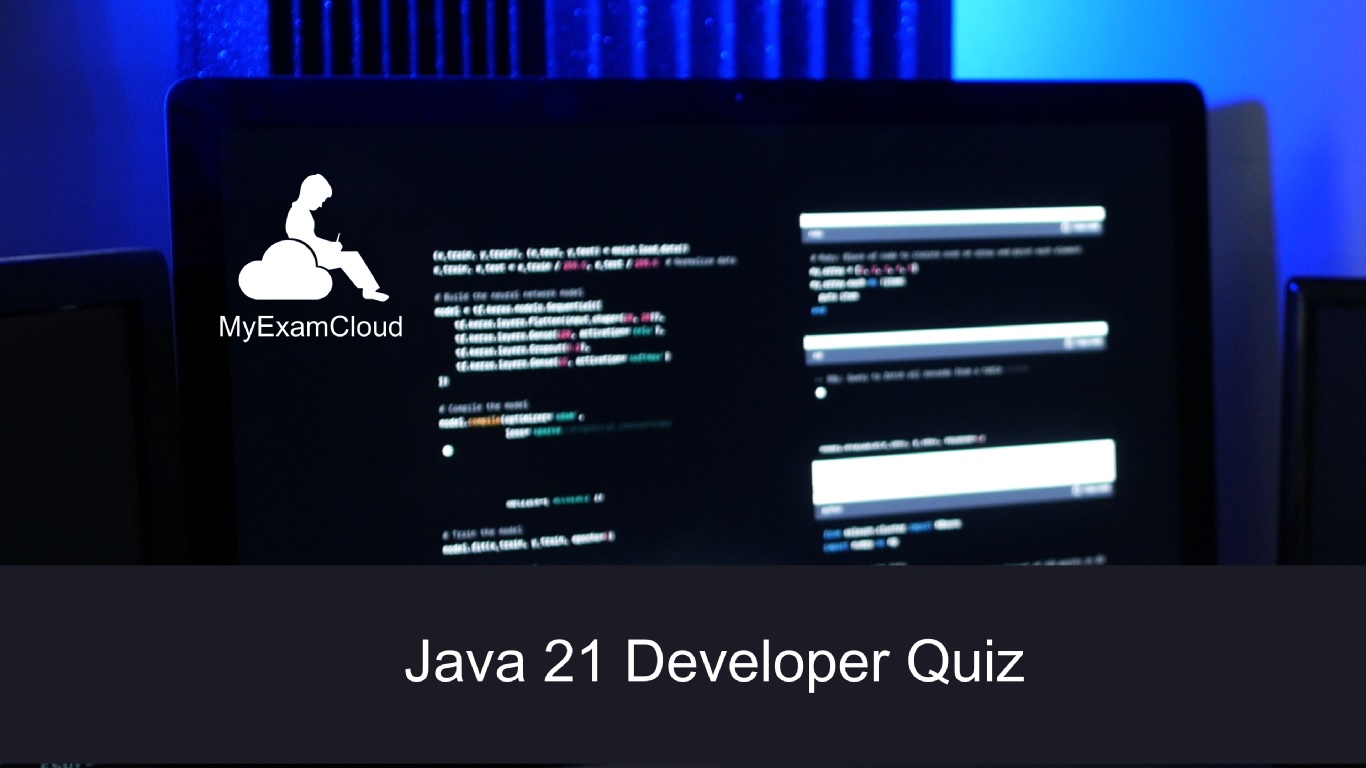
Java 21 Developer Questions and Answers
MyExamCloud 1Z0-830 Practice Tests | Java SE 21 Developer Certified Professional Mock Questions
1. What is the primary purpose of records in Java SE 21?
A) To hold data
B) To handle exceptions
C) To create secure encryption algorithms
D) To represent sequenced collections
Answer: A) To hold data. Records are a new feature in Java introduced in version 16 and finalized in version 21. They are designed for holding data in an efficient and compact way.
2. How can we use pattern matching to destructure and access properties of a record instance?
A) By using the instanceof operator
B) By using the equals() method
C) By using the toString() method
D) By using the getClass() method
Answer: A) By using the instanceof operator. Pattern matching allows us to use patterns in switch case labels and also destructure record instances using the instanceof operator.
3. Which of the following is NOT a built-in processor for string templates in Java SE 21?
A) STR
B) FMT
C) RAW
D) EVAL
Answer: D) EVAL. The built-in processors for string templates in Java SE 21 are STR, FMT, and RAW.
4. How can virtual threads improve the scalability and concurrency of Java applications?
A) By sharing OS threads
B) By using thread local variables
C) By removing duplicate elements from collections
D) By providing a defined encounter order
Answer: A) By sharing OS threads. Virtual threads, also known as Project Loom, are a new feature in Java SE 21 that offer a lightweight alternative to platform threads by sharing OS threads.
5. How do sequenced sets and maps differ from sequenced collections in Java SE 21?
A) They allow duplicates
B) They maintain a specific order for their elements
C) They extend the Map interface
D) They use asymmetric keys for encryption and decryption
Answer: B) They maintain a specific order for their elements. Sequenced sets and maps have a defined order for their elements, similar to the LinkedHashSet and SortedMap in the Collections framework. Sequenced collections, on the other hand, allow duplicates and maintain a specific order for their elements.
6. What is the primary purpose of the Key Encapsulation Mechanism API in Java SE 21?
A) To generate secure symmetric keys using asymmetric keys
B) To provide a defined encounter order for elements in collections
C) To handle exceptions and errors in KEM algorithms
D) To create virtual threads for improved concurrency
Answer: A) To generate secure symmetric keys using asymmetric keys. The Key Encapsulation Mechanism API, introduced in Java SE 21, allows applications to generate secure symmetric keys using asymmetric keys.
7. Which of the following algorithms is NOT supported by the KEM API in Java SE 21?
A) NIST KEM
B) Custom vendor algorithms
C) RSA
D) User-provided algorithms
Answer: C) RSA. The KEM API in Java SE 21 supports a variety of algorithms, including NIST KEMs, custom vendor algorithms, and user-provided algorithms. RSA is not listed as a supported algorithm.
8. What is the default accessibility of records in Java SE 21?
A) Public
B) Private
C) Protected
D) Final
Answer: A) Public. Records are public by default.
9. How can we create an instance of a record in Java SE 21?
A) Using the new keyword and a constructor
B) Using the equals() method
C) Using the toString() method
D) Using the getClass() method
Answer: A) Using the new keyword and a constructor. Just like regular classes, records can be instantiated using the new keyword and a constructor.
10. What is the main benefit of using string templates in Java SE 21?
A) They improve the performance of string concatenation
B) They provide a standard way to handle exceptions
C) They offer a way to destructure and access record properties
D) They allow for more concise and readable code
Answer: D) They allow for more concise and readable code. String templates in Java SE 21 combine literal text with template expressions and processors to produce a desired result, making code more concise and readable.
Read more at https://www.myexamcloud.com/blog/java-se-21-developer-certified-professional-1z0-830-Certification-preparation.article
| Author | JEE Ganesh | |
| Published | 8 months ago | |
| Category: | Java Certification | |
| HashTags | #Java #Programming #Software #JavaCertification |


